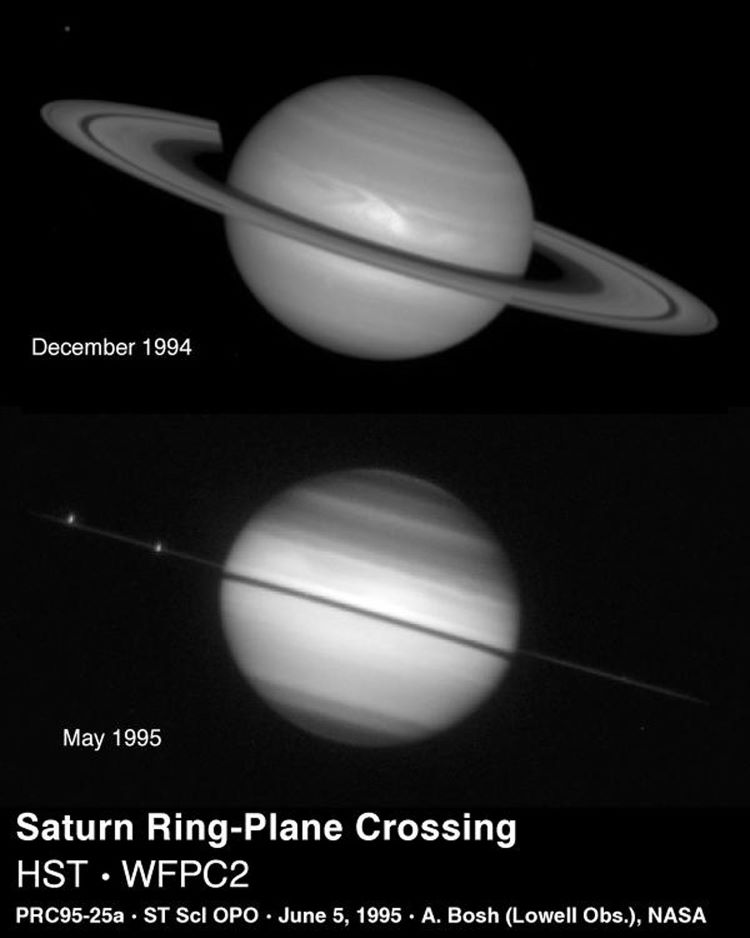The rings of Saturn are some of the most well-known and captivating spectacles in the night sky, which are so large they can easily be observed with amateur telescopes or even a pair of high-powered binoculars. However, from time to time, Saturn’s rings “disappear” from view, a phenomenon known ring-plane crossing, with the rings being observed as a flat line running straight through the massive gas giant. Ring-plane crossing occurs approximately every 15 years and is slated to happen next in March 2025, with the rings slowly getting “larger” in the months afterwards before “disappearing” again in November 2025. But what causes ring-plane crossing?
Saturn’s ring-plane crossing is due to the viewing angles from Earth changing as both planets are tilted during their respective orbits around our Sun and orbit at different speeds and times, as the Earth orbits the Sun in one year, Saturn takes approximately 29.4 years to complete one orbit. As a result, our view of Saturn changes over time, and the “size” of the rings appear to get larger and smaller, and periodically disappear entirely from view for a short time. As noted, ring-plane crossing happens approximately every 15 years, with the most recent occurrence being observed directly from Earth happening in 2009. However, both the 2009 and 2025 events are not observable from Earth since Saturn will be too close to the Sun.
NASA’s Hubble Space Telescope captured some fantastic images of Saturn’s rings edge-on in 1995, which provided astronomers the opportunity to observe some of Saturn’s larger moons and try to discover new moons, as well. The reason why ring-plane crossing allows astronomers to find new moons is due to the decreased glare of the bright rings that normally obscure smaller objects orbiting Saturn from being seen. In fact, between 1655 and 1980, ring-plane crossing is responsible for astronomers discovering 13 new moons of Saturn, with additional moons of Saturn being discovered by NASA’s Voyager 1 spacecraft in 1980. Two of Saturn’s most well-known moons, Enceladus and Mimas (aka the Death Star), were discovered by William Herschel during the ring-plane crossing of 1789-1790, and Hyperion was discovered during the ring-plane crossing of 1848-1849.

Ring-crossing was accidentally discovered by Galileo Galilei in 1612, who is also responsible for first discovering Saturn’s rings only two years earlier. When he observed the rings had apparently disappeared, he wrote in his notes, “I do not know what to say in a case so surprising, so unlooked for and so novel”.
As noted, ring-plane crossing occurs due to the combination of the tilts of Earth and Saturn and their respective orbits, which also influences the north-south direction of the rings during the crossing. For example, the ring-plane crossing event occurring in March 2025 will see Saturn’s rings proceed from south to north, but this contrasts with the ring-plane crossing event that will occur several decades from now in August 2068. For this event, the rings will proceed from north to south.
While ring-plane crossing causes Saturn’s rings to give the illusion they are “disappearing”, this illusion won’t be around forever. This is because the icy grains that comprise Saturn’s rings are slowly being lost to the planet with a 2019 study used ground-based observations to estimate the rings will be gone for good in approximately 292 million years. Most recently, a 2023 study used data from NASA’s Cassini mission to provide a larger range of the remaining lifespan of Saturn’s rings at between 15 to 400 million years.
What new discoveries will astronomers make using Saturn’s ring-plane crossing in the coming years and decades? Only time will tell, and this is why we science!
As always, keep doing science & keep looking up!
The post Saturn’s Rings will Disappear in 2025. Don’t Worry, They’ll Return Soon Enough appeared first on Universe Today.
No comments:
Post a Comment